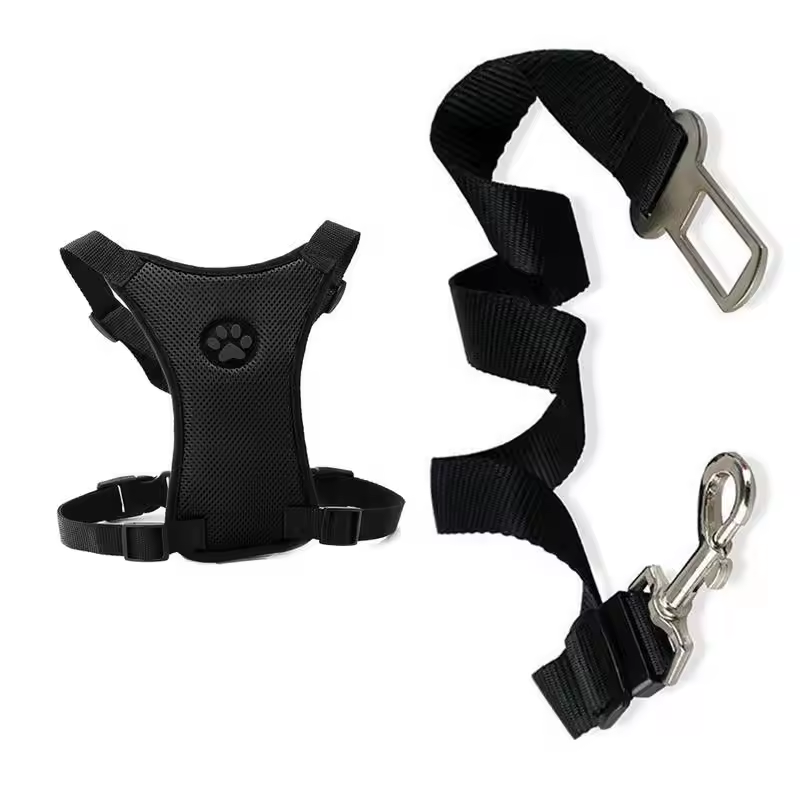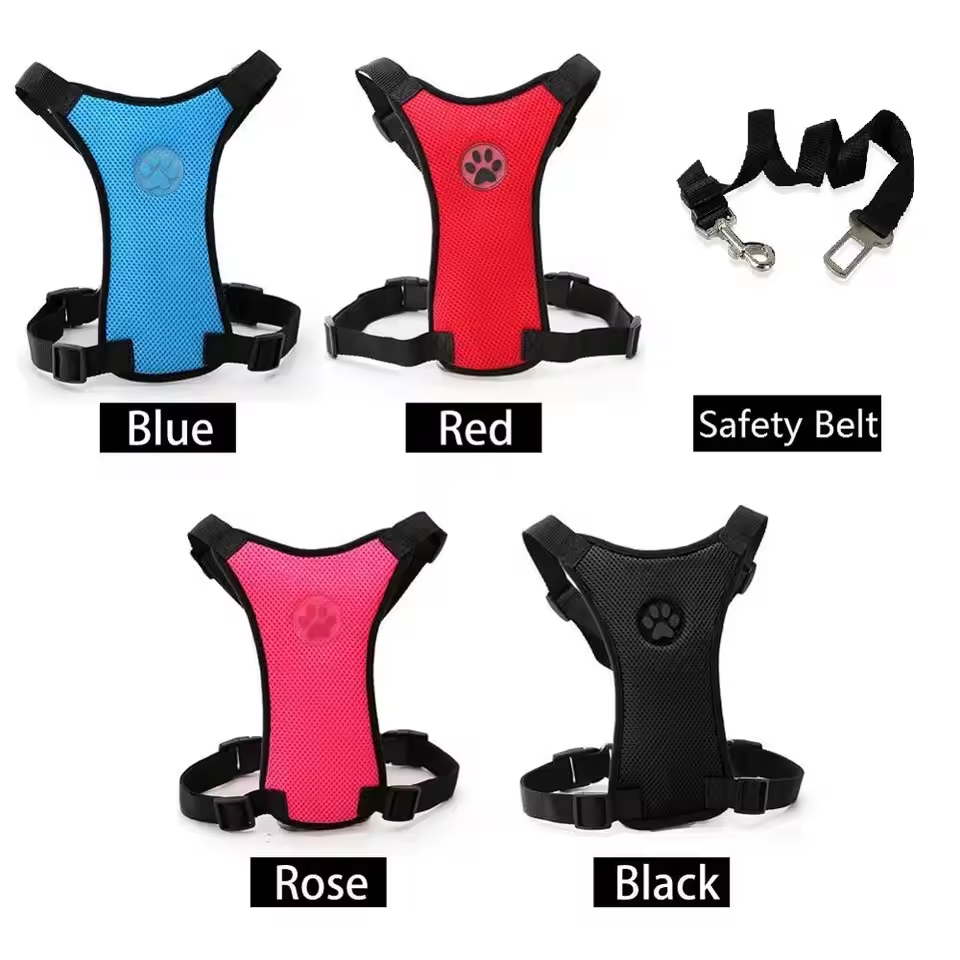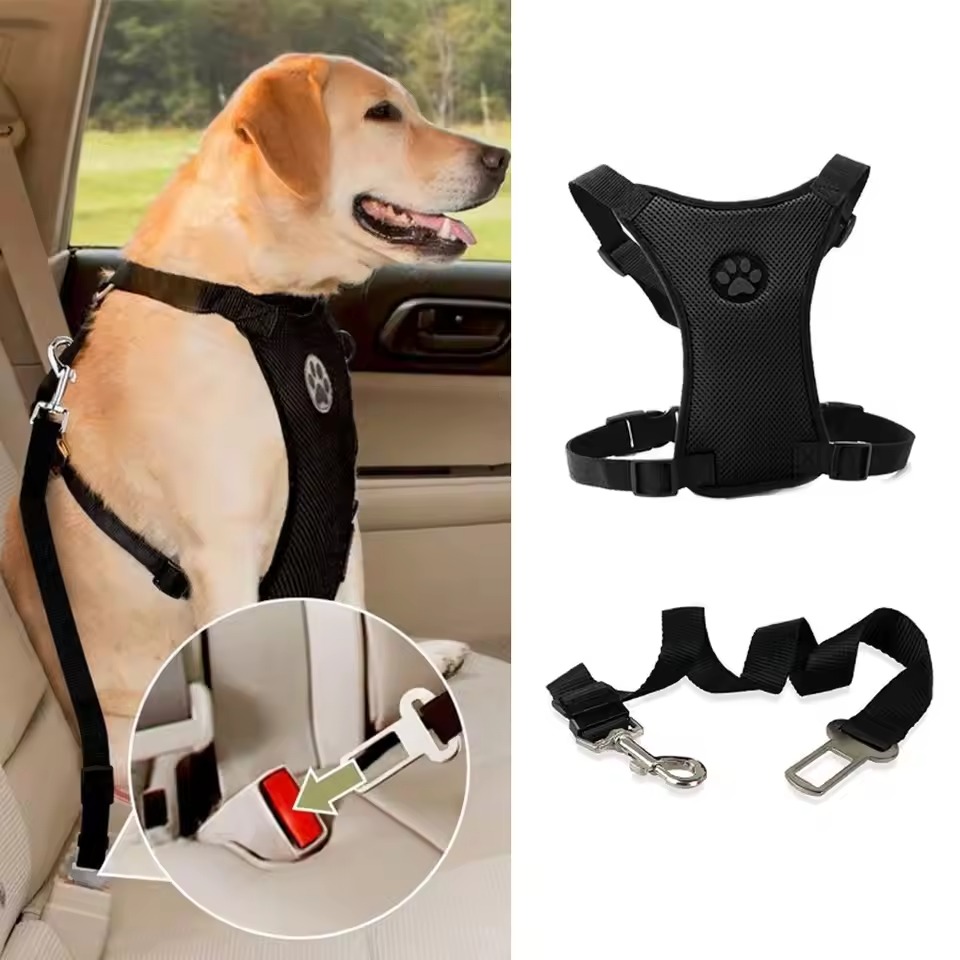The Importance of Dog Seat Belt Harnesses
Ensuring the safety of our furry friends during travel is crucial. Dog seat belt harnesses are vital for various reasons. Firstly, they restrain your dog from moving around the car. This is important for their safety as well as yours. A loose pet can distract the driver, leading to accidents. In the event of a crash, a harness can protect your dog from injury. It keeps them secured to the seat and prevents them from becoming a projectile.

Another key point is the legal aspect. In some places, securing your dog with a dog seat belt harness is the law. Not following these regulations can result in fines. Lastly, having your pet securely fastened with a dog seat belt harness helps emergency services. If they need to assist you, they won’t be hindered by a loose pet in the car. It’s clear that a dog seat belt harness offers both safety and peace of mind when traveling.
Types of Dog Seat Belt Harnesses
When looking for a dog seat belt harness, you’ll find several types. Each type caters to different needs and preferences.
Standard Harnesses
Standard harnesses are the most common and straightforward option. They often have a loop at the back which you attach to the seat belt. These harnesses are good for short trips.
Vest Harnesses
Vest harnesses provide more coverage and support. They distribute force across a larger area, making them safer in a sudden stop.
Tether Harnesses
Tether harnesses include a leash-like attachment. You hook this to the car’s latch system. This type is adjustable for your dog’s range of movement.
Booster Seat Harnesses
Booster seat harnesses elevate small dogs. This gives them a view outside and secures them in place. It’s a good mix of safety and comfort.
These are some key types of dog seat belt harnesses. Choose one that suits your dog’s size, breed, and behavior while traveling.
How to Choose the Right Dog Seat Belt Harness
Choosing the right dog seat belt harness is critical for your pet’s safety and comfort. It’s not just about picking any harness but finding one that suits your dog’s specific needs. Here’s how you can make the right choice:
Consider Your Dog’s Size and Weight
Size and weight determine the harness size. A harness that is too tight can cause discomfort, while one too loose may not be safe. Measure your dog’s chest and neck properly.
Look at the Type of Harness
Recall the types of harnesses discussed earlier. Match the harness type to your dog’s habits and length of the trip.
Check Adjustability Features
Make sure the harness can adjust to fit snugly. This feature helps in providing a comfortable yet secure fit as your dog grows or changes in size.
Assess the Material Quality
Choose durable materials that can withstand wear and tear. Also, materials should be comfortable against the dog’s skin to prevent irritation.
Ensure Ease of Use
A good harness is easy to put on and take off. This is especially important in emergency situations. Look for harnesses with simple buckling systems.

Reflective Strips for Visibility
If you travel at night, reflective strips are vital. They make your dog visible to you and others, adding an extra layer of safety.
By taking the time to assess these factors, you can choose a dog seat belt harness that ensures safety, complies with legal standards, and makes travel enjoyable for you and your dog. Remember to look for a balance between safety features and comfort measures when making your choice.
Installation Tips for Dog Seat Belt Harnesses
Proper installation of a dog seat belt harness is key to its effectiveness. Here are some tips for ensuring that your dog’s harness is installed correctly:
Choose the Right Location in Your Vehicle
Select a spot where your dog can sit or lie down comfortably. Avoid airbag areas for small dogs. The back seat is typically the best choice.
Follow the Manufacturer’s Instructions
Every harness comes with a guide. Read it thoroughly before starting. This ensures that you install the harness as intended.
Secure the Harness to the Seat Belt or Latch System
Attach the harness loop to your car’s seat belt and fasten it. If it’s a tether harness, hook it to the latch system under the seat.
Adjust for a Snug Fit
After securing the harness, adjust the straps. They should be tight enough to hold your dog, but not so tight that they cause discomfort.
Double-Check All Connections
Once installed, pull on the harness and seat belt to check they’re secure. All connectors should be firm with no slack.
Allow Your Dog to Acclimate
Let your dog wear the harness inside the house first. Then, do short trips to get them used to it before a longer journey.
By following these tips, you can rest assured that you’ve maximized the safety benefits of your dog seat belt harness. Remember, a well-installed harness can make travel safer for both you and your pet.
Comfort Features to Look For in a Dog Seat Belt Harness
When choosing a dog seat belt harness, comfort is just as important as safety. The right harness will help your dog stay calm and happy, even on long rides. Here’s what to look for to ensure your dog’s comfort:
Padding
A harness with soft padding can prevent chafing. Look for one with padded chest plates. This will keep your dog comfortable on the road.
Breathable Material
Choose materials that let air flow. This keeps your dog cool, especially in warm weather. Mesh linings are often a good pick.
Flexibility in Movement
Your dog should be able to sit, lie down, and turn around. A harness that allows for natural movement will prevent restlessness.
Adjustable Straps
Straps that adjust can provide a custom fit. A well-fitted harness won’t pinch or dig into your dog’s body.
Lightweight Design
A heavy harness can be burdensome. Opt for lightweight materials that won’t weigh your dog down.
Easy to Clean
Look for a harness that is easy to wipe down or machine wash. Cleanliness adds to comfort, especially after long trips.
By looking for these comfort features, you ensure that your dog is not only safe but also enjoys the journey. A comfortable dog seat belt harness is a win-win for you and your pet during travel.

Safety Standards and Certifications for Dog Seat Belt Harnesses
When it comes to the safety of dog seat belt harnesses, standards and certifications are key. These guidelines show that a harness has passed certain tests for durability and strength. There are several certifications to look for when choosing a harness.
Look for Certifications
Check if the harness has certifications from reputable organizations. This might include the Center for Pet Safety (CPS) or similar bodies. Products with their seal of approval meet high safety standards.
Crash Testing
Choose a harness that has undergone crash testing. This ensures it can protect your dog during a collision. Look for harnesses tested by independent third-party testers.
Materials Used
Quality materials matter for safety. Harnesses should use strong, automotive-grade fabrics and metal. Such components improve the harness’s overall safety performance.
Design Standards
A well-designed harness will distribute force across the dog’s body. This reduces the risk of injury in an accident. Look for harnesses with a good safety design.
Regular Updates
Makers of safe harnesses often update their products. They follow the latest research to improve safety features. Choose a brand that stays current with safety developments.
By considering these safety standards and certifications, you can select a dog seat belt harness you trust. Always check for the latest safety features to ensure the well-being of your pet.
The Best Dog Seat Belt Harnesses on the Market
Selecting the best dog seat belt harness requires research and understanding of the market’s top offerings. The market boasts a range of harnesses acclaimed for their safety features, comfort, and ease of use. Below we discuss some of the prime dog seat belt harness options available, keeping in mind your furry friend’s security on the road.
Before you purchase, remember to check the size and fit for your dog. Then, explore the features. The best harnesses provide ample padding, adjustability, and durable materials. Also, look for those that have passed rigorous safety tests. Certifications from bodies like the Center for Pet Safety indicate a reliable choice. Products that have undergone crash testing are even more trustworthy.
Now, focus on brands popular for their quality. Some have a long-standing reputation for making dog travel gear. They offer a variety of styles and sizes. Aim to get one that balances safety and comfort without being too complex to secure onto your dog. If you travel at night or during poor visibility conditions, choose one with reflective strips. This will increase your dog’s visibility.
Lastly, consider the ease of maintaining the harness. Is it machine washable or easy to wipe clean? This aspect is crucial for keeping the harness hygienic over time.
Take your time to compare different products. Read reviews and watch for any recent safety recalls. The best harness for your dog is one that meets your specific travel needs while also keeping your pet secured and comfortable on the go.
Maintenance and Care for Your Dog Seat Belt Harness
Ensuring the longevity and effectiveness of your dog seat belt harness requires proper maintenance. Here’s what to consider for the care of your harness.
Regular Cleaning
Keep the harness clean to ensure comfort and hygiene. Remove dirt, fur, and debris after each use. Follow the washing instructions if it is machine-washable.
Inspect for Wear and Tear
Check the harness regularly for signs of wear. Look closely at the straps, buckles, and stitching. Replace the harness if you see any damage.
Store Properly When Not in Use
When not in use, store the harness in a dry, cool place. This will prevent mold and mildew and keep it ready for the next trip.
Follow Manufacturer Guidelines
Use the harness as directed by the maker. This will prevent unnecessary stress on the material. Also, follow their guidelines for the best care practices.
Address Issues Promptly
If you spot a problem, fix it right away. Delaying repairs could compromise safety. Check with the manufacturer for repair services or advice.
By following these maintenance steps, you ensure the dog seat belt harness stays in top condition. This maintains safety and comfort for your pet during travel.